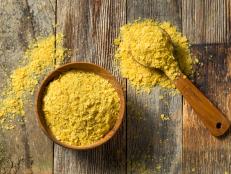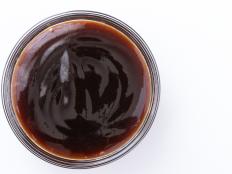What Is Tempeh? And How to Cook with It
This ancient fermented staple is a complete plant protein, meaning it contains all nine essential amino acids that your body is unable to produce.
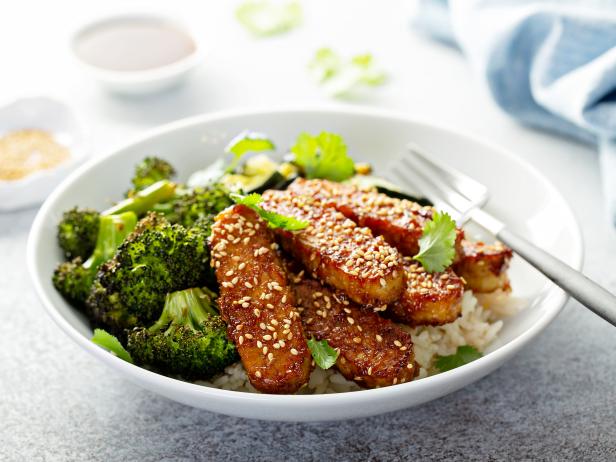
VeselovaElena/Getty Images
By Amy Gorin, MS, RDN for Food Network Kitchen
Amy Gorin, MS, RDN, is a registered dietitian nutritionist and owner of Plant-Based Eats in Stamford, CT.
What Is Tempeh?
No doubt you’ve heard of soybeans. But what about the plant-based protein’s fermented cousin, tempeh?
Tempeh comes from Indonesia and Malaysia and is typically made from fresh or cooked soybeans and ingredients—a combination of bacteria, fungus and yeast—that ferment the soybeans to create a solid paste, according to research from International Journal of Gastronomy and Food Science.
This tempeh can be eaten as is or cooked. “Tempeh’s flavor might be unfamiliar if you didn’t grow up eating soy foods that are staples in many east and southeast Asian cuisines,” says Cindy Chou, RDN, chef and registered dietitian at Healthy Feels. “But it’s definitely worth trying with different cooking methods.”
Because tempeh is made from soybeans, it’s a complete plant protein—meaning it contains all nine essential amino acids that your body is unable to produce. This is a big deal, but especially for plant-based eaters.
Now, let’s explore whether tempeh is healthy, how it differs from tofu, and how to best prepare it.
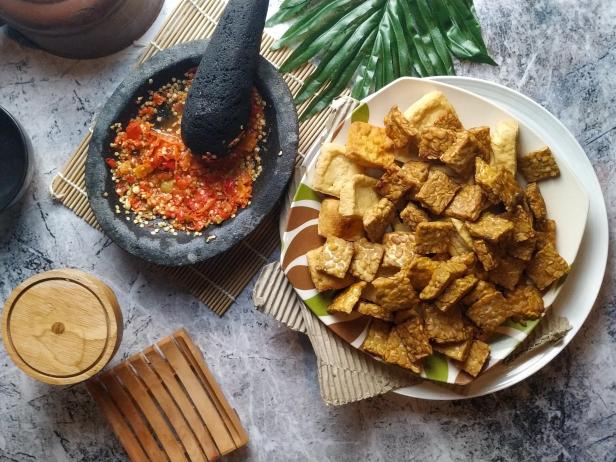
Gunawan Prasetyo/Getty Images
What Does Tempeh Taste Like?
Many different varieties of tempeh exist, and these will all taste a bit different from one another. You’ll find tempeh made with just soybeans and water—and you’ll also find tempeh made with flax or grains such as barley, brown rice, and millet. “Some store-bought tempeh might have a slight bitterness and hint of sourness to it due to the fermentation process, while homemade or fresh tempeh may taste milder,” says Chou.
“Tempeh has a bit of a nutty flavor,” says Melissa Altman-Traub MS, RDN. “Overall, it’s bland on its own, as is tofu. It soaks up the flavors of marinades and sauces it’s paired with.” If you want tempeh to really take on the flavor of sauces it’s paired with, use this trick from Jessica Cording, MS, RD, author of The Little Book of Game Changers: Steam the tempeh for a good ten minutes before cooking it with a sauce. This allows it to become very tender—and able to soak up more sauce and flavor.
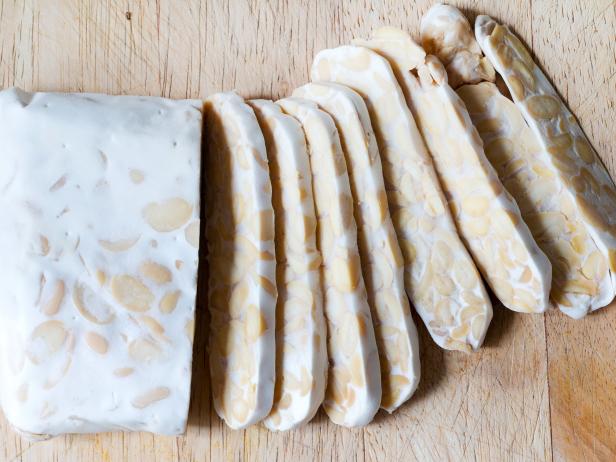
photograph by dorisj/Getty Images
Is Tempeh Healthy?
The short answer: Yes, tempeh is considered a healthy food. A 3.5-ounce serving provides 20 grams of protein for just 192 calories, per the USDA FoodData Central database. And tempeh is an excellent source of protein, which isn’t so easy to find in plant-based foods. It’s also an excellent source of fiber, and this combination of protein and fiber helps to keep you satiated for longer—which can be beneficial for weight management.
The benefits don’t stop there. Tempeh is a good source of iron, a nutrient that vegetarians and vegans need to make sure they get enough of. And it offers a bit of bone-helping calcium. “Tempeh is packed with protein and can be a source of vitamin B12, an essential vitamin commonly missing in plant foods, depending on the brand or how it’s made,” notes Chou. “Additionally, it provides prebiotics to support digestive health.”
And let’s not forget that soy offers many benefits. “Tempeh is an example of a whole soy food,” says Cording. “And soy, when consumed in its whole form, has been associated with numerous health benefits such as improved bone health, improved cholesterol and decreased risk of some cancers like breast cancer.”
Is Tempeh Vegan?
Wondering if tempeh is vegan? It is, as it contains no animal products.
Is Tempeh Gluten-Free?
But it’s not necessarily gluten-free. If you follow a gluten-free diet, you’re best off skipping tempeh that’s made with grains—as most contain barley.
What’s the Difference Between Tempeh and Tofu?
If tempeh and tofu are both made with soybeans, how do the two differ? While tempeh origin’s lie in Indonesia, tofu originated in China.
“The most noticeable differences between tempeh and tofu are texture, mouthfeel, and flavor,” says Chou.
Then there’s firmness: “Tempeh’s texture is firm and dense,” adds Chou. “You can feel the whole soybeans when eating it, while tofu is a lot softer and has a smooth texture. The nutty flavor of soy is more prominent in tempeh, as well.”
Nutritionally, tempeh boasts more protein and fiber than tofu. On the other hand, tofu tends to contain more iron than tempeh. For more information on the differences between tempeh and tofu, head over to our article What’s the Difference Between Tempeh, Tofu and Seitan?.
Where Can I Buy Tempeh?
Tempeh is available in most health food stores, as well as in the produce section of major supermarkets near other refrigerated plant-based substitutes.
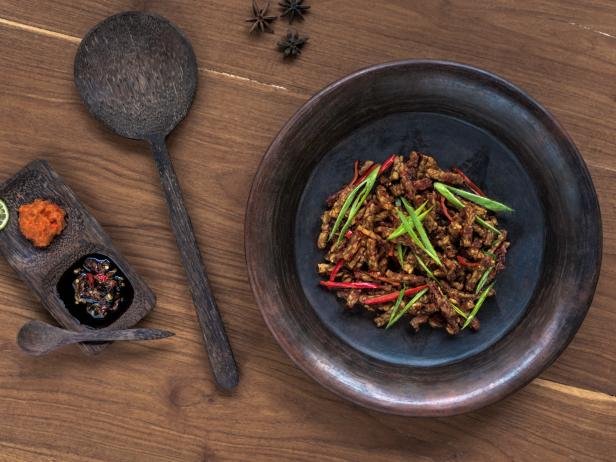
Martin Puddy/Getty Images
How to Start Cooking with Tempeh
When it comes to preparing tempeh, you have so many options! “Thinly sliced, diced or steamed—and then crumbled—tempeh is delicious slowly simmered in a flavorful sauce and then pan-fried to crisp up the outer surface,” says Chou. “You can get creative with combining aromatics, savory and sweet sauces and even spices with a smoky flavor like sweet smoked paprika.”
You can also marinate and then pan-fry or grill tempeh. If you want the edges to get nice and crispy, slice the tempeh thinly before cooking. You can add it to a sandwich—just slice, marinate it and bake. Or crumble and add to sauces or stews for a protein boost.
Deep frying is also a traditional way to enjoy tempeh, which crisps up nicely on the outside. Serve fried tempeh with sambal dipping sauce, rice and vegetables.
Tempeh Recipes

Here, a take on the traditional Indonesian dish gado-gado, a salad of tempeh and vegetables in peanut dressing. This recipe has a robust, tropical flavor thanks to peanut butter, coconut milk and ginger. Seitan is shallow-fried in peanut oil until it’s delightfully golden brown.

Tempeh bacon (which you can buy premade) ups the ante on these sandwiches, which are loaded with sauerkraut slaw, Russian dressing, dill pickles and Swiss cheese.
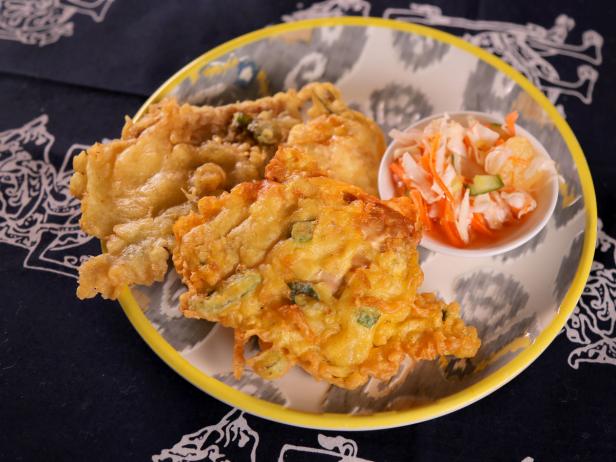
Citizen Pictures
This recipe walks you through how to DIY tempeh, starting with soybeans that’ll ferment over the course of two days. Bread the tempeh cakes and fry them up for crispy results that’ll disappear in a matter of seconds.
Related Links:


























